
 Sainavle
Sainavle
WBCHSE Class 11 Biology Notes For Cardiac Output
Cardiac Output
Cardiac Output Definition: Cardiac output is the volume of blood pumped by each ventricle per minute.
Cardiac output depends on the frequency of heartbeat as well as the volume of blood ejected in one contraction.
It is expressed as minute volume or litres of blood per minute. The usual values of cardiac output for adults when at rest are 5 to 6 L/min or approximately 8% of body weight per minute.
With strenuous activity, an adult’s cardiac output can increase to almost 25 L/min to satisfy the body’s demands for nutrients and oxygen. Cardiac output is a product of heart rate (beats/ minute) and stroke volume.
Read and Learn More Class 11 Biology Notes
The amount of blood pumped by each ventricle with each heartbeat is called stroke volume.
In a healthy adult at resting condition, the stroke volume is 70 ml of blood. Cardiac output is calculated by the formula— Cardiac Output (CO) = Stroke Volume (SV) x Heart Rate (HR) So, the cardiac output is 70 x 72 = 5040 ml min’1 or approximately 5 litres min’1.
cardiac output definition
The cardiac output represents the volume of blood that is delivered to the body. It is an important factor in the determination of the effectiveness of the heart to deliver blood to the rest of the body.
“WBCHSE class 11 biology notes for cardiac output”
Cardiac Index And Stroke Volume Index
Normal, resting cardiac output differs among individuals. Therefore, in clinical practice, measured values for cardiac output are often expressed as a flow (L/min) per body surface area (m2) which is called cardiac index.
It is the volume of blood released by each ventricle of the heart per minute to the body surface.
The surface area is estimated from calculations based on body weight and height. Cardiac index normally ranges from 2.6 to 4.2 L/min/m2.
| Class 11 Biology | Class 11 Chemistry |
| Class 11 Chemistry | Class 11 Physics |
| Class 11 Biology MCQs | Class 11 Physics MCQs |
| Class 11 Biology | Class 11 Physics Notes |
The stroke volume index is the volume of blood released during each heartbeat with respect to the surface area of the body. The average value of stroke volume index in a healthy adult human is 47ml.
In 1870, German physiologist Adolf Fick contrived the first method for measuring cardiac output in animals and human beings.
” cardiac output formula”
The basis of this method is called Fick’s principle. This principle states that the amount of any substance received by an organ per unit of time is equal to the arterial level of the substance minus the venous level times the blood flow.
So Blood flow through an Organ In a given time =
Amount of substance removed from or added to blood during the same time period/ A- V difference of concentration of the substance/ml. of blood.
“detailed explanation of cardiac output for class 11 WBCHSE”
Over the past decades, many methods for cardiac output measurement have been developed like thermodilution method, oesophageal Doppler method, transoesophageal echocardiography, pulse contour cardiac output, lithium dilution cardiac output measurement, etc.

factors affecting cardiac output
Factors Controlling Cardiac Output
Maintaining and regulating cardiac output is one of the most intricate functions of the circulatory system.
The cardiac output is the product of stroke volume and heart rate. Therefore, factors regulating stroke volume and/or heart rate are able to control it.
The key factors regulating cardiac output are given below—
Sympathetic stimulation: Increased sympathetic stimulation (due to fright, anger, etc.) increases the heart rate. It also increases stroke volume by increasing contractility, which results in a more complete ejection of blood from the heart.
Hence, cardiac output increases which is again brought to normal by increased parasympathetic activity after sympathetic stimulation.
Venous return: Cardiac muscle fibres are stretched by increased blood volume returning to the heart.
“factors affecting cardiac output in human circulatory system”
Increased stretch results in a greater force of contraction, which increases stroke volume and thereby cardiac output. Decreased venous return decreases cardiac output.
Heart rate: Increased heart rate decreases stroke volume but increases cardiac output. Excessive increase in the heart rate decreases cardiac output.
Myocardial contractility: Increased myocardial contractility results in increased cardiac output.
The strength of the force of myocardial contraction depends on the initial length of cardiac muscle fibres, nutrition and availability of oxygen, concentration of H+ ions, etc.
Peripheral resistance:
- The pressure against which ventricles pump blood is called afterload.
- This is determined by the resistance of arterioles to blood flow, which is called peripheral resistance.
- Increased peripheral resistance will reduce the volume of blood flow through the arteries and will in turn increase afterload.
- This will lower the stroke volume and thereby decrease cardiac output. Thus, peripheral resistance is inversely proportional to cardiac output.
Exercise: Exercise activates the sympathetic nervous system, increasing heart rate and contractility of the myocardium. Both of these actions increase venous return, contributing to increased stroke volume. Hence, cardiac output is increased.
Blood pressure
Blood pressure can be defined as the lateral pressure exerted by the flowing blood on the walls of the blood vessels (especially the arteries).
Types of blood pressure are—
Systolic blood pressure: The peak value of pressure exerted by the blood on the walls of the arteries during ventricular contraction or systole, is known as systolic blood pressure. Normal systolic blood pressure in an adult is in a range of 105-135 mm Hg (average 120 mm Hg) during each cardiac cycle.
“factors affecting stroke volume “
Diastolic blood pressure: The minimum pressure exerted by the blood on the walls of the arteries during ventricular relaxation or diastole, is known as diastolic blood pressure. Normal diastolic blood pressure in an adult is about 80mm Hg (60 – 90 mm/Hg).
Pulse pressure: The term pulse refers to the alternating surges of pressure (expansion and then recoil) in an artery that occurs with each contraction and relaxation of the left ventricle. This difference between systolic and diastolic pressure is called pulse pressure.
“how to calculate cardiac output with formula and examples”
Normally the pulse pressure is SBP-DBP = (120-80)= 40mm Hg.
Mean arterial pressure: Mean arterial pressure (MAP) is the average pressure during the cardiac cycle. The value of MAP varies at different levels of the circulatory system.
Blood pressure can be measured directly or indirectly
Direct measurement of blood pressure is done by cardiac catheter with the help of a pressure transducer or by putting a needle in an artery and connecting with a pressure transducer or simply a Hg manometer.
Indirect measurement of blood pressure involves auscultatory palpatory or oscillatory method by using a sphygmomanometer.
commonly called a blood pressure cuff, is an instrument used to obtain blood pressure readings by the auscultatory method.
Electrocardiogram [ECG]
Electrocardiogram Definition: The electrocardiogram (ECG) is a graphic representation of the electrical activity of the heart recorded during the cardiac cycle.
Discovery: In 1887, Augustus D Waller recorded the first electrocardiogram. After that in 1903, Willem Einthoven studied the details of ECG and he is known as the father of ECG. After 1930, many advanced forms of ECG have been developed.
Description: The electrical activity of the heart is monitored and recorded on the ECG. The process of recording ECG is known as electrocardiography. An ECG configuration may consist of waves, and intervals recorded as voltage against time. A single waveform begins and ends at the baseline.
“difference between stroke volume and cardiac output notes”
Electrocardiograph
Cardiac impulse, generated from the SA node, is transported to all tissues of the heart as electrical impulse via the AV node, a bundle of His, Purkinje fibre, etc., and all over the body through cells and blood.
So, the electrical activity of the heart can be observed by using electrodes at different parts of the body. The instrument used to measure these activities is known as electrocardiograph.
Einthoven’s triangle
During electrocardiography, an imaginary triangle is formed with three limb leads or electrodes (two shoulders and one left leg) by keeping the heart at the centre. This is known as Einthoven’s triangle
Methods of ECG recording: There are various methods for ECG recording. The electrodes that are used for the procedure, are placed in different parts of the body. Generally, there are two types of methods for electrocardiography—unipolar and bipolar ECG methods.
Waves Of Electrocardiogram
The ECG recorded on graph paper is composed of five types of waves— P, Q, R, S and T.
The P wave: The normal cycle of electrical activity in the heart begins with atrial depolarisation and is recorded as the P wave.
The shape of the P wave is usually symmetrical and upright. The normal duration of the P wave is 0.08 to 0.11 seconds.
The QRS complex: The QRS complex represents ventricular depolarization.
“importance of cardiac output in blood circulation WBCHSE notes”
The QRS complex consists of three separate waveforms—
Q wave, R wave, and S wave. The first negative deflection (below the baseline) after the P wave is the Q wave.
The next tall positive deflection (above the baseline) is the R wave. The S wave is the small negative deflection (below the baseline) that follows the R wave. Under normal conditions, the duration of the QRS complex is less than 0.10 seconds.
The ST segment: The ST segment represents the time between ventricular depolarization and repolarization.
It begins at the end of the QRS complex (called the J point) and ends at the beginning of the T wave. Normally, it measures 0.12 seconds or less.

The T wave: The T wave represents ventricular repolarization, rest, and recovery. Its duration normally measures 0.20 seconds or less.
T waves are sensitive T indicators for the presence of a number of abnormalities.
The U wave: The U wave follows the T wave and has the same polarity (deflection) as the T wave. Its origin and mechanism are not known. Due to its low voltage, it is usually flat and almost not visible.
The PR interval: The PR interval starts at the beginning of the P wave and ends at the beginning of the QRS complex.
The normal duration of the PR interval is 0.12 to 0.20 seconds. The PR interval represents the total atrial (supraventricular) electrical activity prior to the activation of the bundle of His, ventricular branches, and Purkinje fibre system.
The QT interval: The QT interval is measured from the beginning of the QRS complex to the end of the T wave.
“heart rate, stroke volume, and their role in cardiac output”
The QT interval represents total ventricular activity. The normal QT interval measures about 0.38 seconds and varies in males and females and with age.
Significance Of ECG
Electrocardiography is an indispensable tool in the diagnosis, prognosis and therapeutic aspect most of cardiac disorders.
From the ECG tracing, the following information can be determined—
- Heart rate and heart rhythm,
- Conduction abnormalities,
- A prior heart attack,
- Chances of coronary artery disease,
- Abnormal thickness of heart muscle.
An electrocardiogram captures the electrical activity of the heart, so it can give information about the following conditions—
- Myocardial Infarction,
- Re-entry pathways in the electrical system,
- Location of the heartbeat initiator, types of cardiac arrest (ventricular fibrillation, a systole, etc.) and other different changes in the electrical activity of the heart.
Double Circulation
Double Circulation Definition: When pathways, blood flows through called double the heart circulation.
Double circulation involves the movement of blood through the heart twice during each trip of the body.
The two pathways involved in this area—
Pulmonary circulation (i.e., transportation of blood from the heart to the lungs) and systemic circulation (i.e., transportation of blood from the heart to the rest of the body).
A double circulation must have a three or four-chambered heart. The right side of the heart receives deoxygenated blood from all over the body and pumps it to the lungs.
In the lungs, the blood loses CO2 and receives O2. The left side of the heart receives oxygenated blood from the lungs and transports it to all the body parts.
Amphibians, reptiles, birds and mammals have double circulation. Fishes have two-chambered hearts. They have a single circulation pathway.

Mechanism Of Double Circulation
The double circulation in human beings can be divided into— pulmonary circulation and systemic circulation.
Pulmonary Circulation
Pulmonary Circulation Definition: Pulmonary circulation is the movement of blood from the heart to the lungs, and then from the lungs back to the heart again. The pulmonary system begins with the pulmonary trunk and ends in the left atrium.
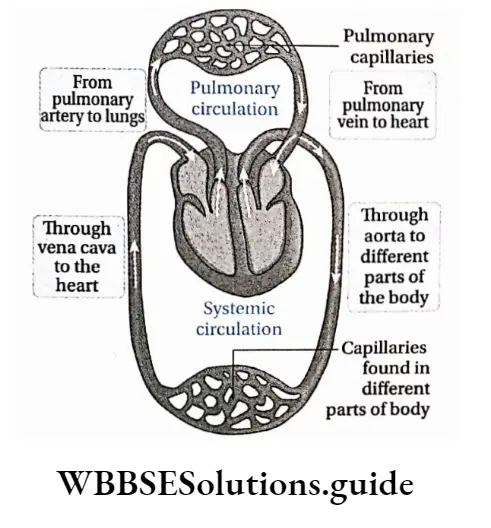
Pathway of circulation:
The pulmonary trunk originating from the right ventricle, divides into right and left pulmonary arteries which enter the right and left lung respectively.
These pulmonary arteries carry deoxygenated blood and divide into smaller arteries, arterioles and capillaries around the lung alveoli.
After gaseous exchange, oxygenated blood from the alveolar capillaries is carried by four pulmonary veins to the left atrium.
Systemic circulation
Systemic circulation Definition: The circulation, in which blood flows from the left ventricle to the body and again returns to the right atrium is known as systemic circulation.
Pathway of circulation:
The aorta originates from the left ventricle and then forms the arch of the aorta. It moves through the lungs as the dorsal aorta. This dorsal aorta crosses the diaphragm and moves into the abdominal cavity. Here, it is known as the abdominal aorta.
The aorta divides into many branches which form capillaries to supply oxygenated blood to different parts of the body.
The visceral capillaries join together to form venules and veins.
Veins combine together and form two main veins—superior vena cava and inferior vena cava. They drain deoxygenated blood into the right atrium from the visceral capillaries.

Regulation Of Cardiac Activity
Cardiac activity in humans is regulated mainly by—neural control and hormonal control.
Neural control: Neural control of the cardiovascular system involves two nerve centres— the cardioinhibitory centre (located in the medulla oblangata of the brain) and the cardioacceleratory centre (located in the vertebral column).
Parasympathetic nerves in the brain and sympathetic nerves in the spinal cord are involved in this regulation.
Stimulation of parasympathetic nerve fibres originating from the cardioinhibitory centre reduces heart rate and blood pressure. This nerve fibre is known as the vagus nerve or 10th cranial nerve.
This nerve fibre is distributed in the SA node, AV node and atrial muscles. Stimulation of sympathetic nerve fibres originating from the cardio accelerator centre of the spinal cord increases heart rate, blood pressure and contractility of cardiac muscles.
These nerve fibres are distributed in the SA node, AV node and the cardiac muscles.
Baroreceptors are a type of sensory neurons that are excited by the stretch of the blood vessel or increase in blood pressure.
They are present in different parts of the body. Due to their stimulation, the produced nerve impulse moves to the brain through the nerves.
As a result, the impulses from the cardioinhibitory centre come to the heart through the vagus nerve. This, in turn, reduces heart rate.
“short notes on cardiac output for WBCHSE class 11 exams”
Hormonal control: Various hormones play a role in the control of the cardiovascular system.
Important sites of hormone secretion include the adrenal medulla, posterior pituitary gland, kidney, and atrium of the heart.
The major hormonal role is played by epinephrine and norepinephrine. Other hormones such as thyroxine, arginine, vasopressin and erythropoietin have some effect on the cardiovascular system.
Atrial muscle cells produce atrial natriuretic peptide which plays an important role in this.
Epinephrine and norepinephrine: When the sympathetic nervous system is activated, the adrenal medulla releases epinephrine (>90%) and norepinephrine (<10%), which circulate in the blood.
Epinephrine and norepinephrine have similar direct effects on the heart, but norepinephrine elicits a powerful baroreceptor reflex because it causes systemic vasoconstriction and increases mean arterial pressure.
Myogenic heart
- A myogenic heart is capable of generating an action potential, depolarization and consequent contraction from within the muscle itself instead of receiving any stimulus from a nerve.
- A healthy heart will perform myogenic rhythms that will allow it to beat 60 to 100 times per minute. Myogenic heart is found in animals like molluscs and vertebrates.
Neurogenic heart
The neurogenic heart refers to the highly specialized muscle cells that require neural input to initiate and maintain contractions. The neurogenic heart is found in animals like annelids and arthropods.
Atrial natriuretic peptide (ANP): Atrial natriuretic peptide is a 28-amino acid polypeptide synthesised and stored in the atrial muscle cells. They are released into the bloodstream when the atria are stretched. It decreases blood volume by increasing sodium excretion.
Other hormones: Thyroxine hormone directly affects the SA node of the heart and increases the heart rate.
Arginine vasopressin (AVP) exerts its major effect on the cardiovascular system by causing the retention of water by the kidneys, which regulates blood volume. Erythropoietin regulates RBC synthesis by stimulating bone marrow.
The decrease in hematocrit stimulates its release, which stimulates RBC synthesis.
Therefore, the increase in plasma volume is balanced with a larger RBC mass.
Disorders Related To Cardiovascular System
There are different types of abnormalities found in the function of the heart and in the circulation of blood.
Hypertension or high blood pressure
Hypertension is a transitory or sustained elevation of both the systemic and pulmonary arterial blood pressure to a level that induces cardiovascular damage.
If the blood pressure lies between 120/80 mm Hg and 139/89 mm Hg, it is called prehypertension (to denote increased risk of hypertension).
A blood pressure of 140/90 mm Hg or above is considered as hypertension.
Cause: Though the exact causes of hypertension are usually unknown, there are several factors including smoking, obesity, lack of physical activity, sedentary lifestyle, etc., which may be responsible for this condition.
Types of hypertension: There are two broad categories of hypertension—
Primary or essential hypertension and Secondary hypertension.
Primary hypertension: It may develop as a result of environmental or genetic causes. It accounts for 90% of the total cases.
It is further divided into two types—
Benign or chronic hypertension: In this condition, blood pressure is usually higher than normal over a long time.
It increases the risk of heart attack, stroke, heart failure, or kidney disease.
Malignant or accelerated hypertension: It is caused by extremely high blood pressure. Immediate medical attention is required in malignant hypertension as it can quickly cause serious damage to the eyes, kidneys and brain.
Causes of malignant hypertension include any form of secondary hypertension, complications of pregnancy, use of cocaine, monoamine oxidase inhibitors (MAOIs), oral contraceptives, etc.
Several diseases such as cerebral oedema, and heart failure can be caused by this condition.
Malignant hypertension can be treated by using medicines such as anti-hypertensive drugs.
Secondary hypertension: High blood related to any other disorder or cause is known as secondary hypertension.
Diabetes, renal disease, renovascular hypertension, Cushing’s syndrome, obesity, and hormonal disorders are some common conditions related to secondary hypertension. Secondary hypertension can also occur during pregnancy.
Effects of hypertension: Most people with high blood pressure have no signs or symptoms. Although a few people with early-stage high blood pressure may experience dull headaches, dizzy spells, etc. Hypertension mainly destroys the heart, kidney, blood vessels and brain.
Effect on heart: Hypertension increases the rate and intensity of the contraction of the heart. This may increase the chances of ventricular hypertrophy and failure. It can also increase the risk of clotting of blood in the lungs and ischemic heart diseases. This affects the circulation of blood and O2 in the body.
Effect on brain: Hypertension may cause haemorrhage, stroke, paralysis and ultimately death.
“WBCHSE class 11 biology human heart and cardiac output notes”
Effect on kidney: Hypertension causes high blood pressure in the kidneys. As a result, the renin-angiotensin system activates and ultimately causes kidney failure.
Prevention and treatment:
- This can be mainly prevented by changing lifestyle.
- It can also be prevented by avoiding the consumption of fatty food, cigarettes, alcohol, etc.
- The patient should take anti-hypertensive drugs.
Mainly, two types of medicines are used in case of hypertension—
Vasodilator drugs: These drugs increase the blood flow to the kidneys. This results in the elimination of excess water, thereby reducing blood pressure (by reducing blood volume).
“cardiac output class 11 WBCHSE PDF notes download”
Natriuretic or diuretic drugs: These drugs decrease the absorption of salt and water in the renal tubules and reduce blood pressure.
Hypotension
Abnormally low arterial blood pressure is known as hypotension. For an adult, less than 90 mm Hg systolic pressure and less than 60 mm Hg diastolic pressure describes hypotension.
Hypotension may result in loss of consciousness, nausea, fatigue, lightheadedness, dizziness, abnormalities in blood circulation, etc.
WBCHSE Class 11 Biology Notes For Circulatory System
Circulation And Circulatory System
The Physiological process, by which digested food materials, oxygen, etc., are distributed throughout the body and hormones, enzymes, waste products, etc., are taken to their target sites through a particular fluid known as circulation.
The circulatory system is the organ system found in multicellular organisms that are concerned with the circulation of blood and consist of blood vessels and the heart.
Significance of animals do circulation: Multicellular not have most of their cells in contact with the external environment. Hence, they have developed oxygen, important metabolic substances and metabolic wastes. In the circulatory system, a fluid (blood) is driven through tubes (arteries, veins and capillaries) by a muscular pump (heart).
“short notes on circulatory system for WBCHSE board exams”
Transportation of useful substances to cells: Circulatory systems transport nutrients, waste products, hormones, respiratory gases, blood cells, antibodies and cells involved in the immune system in order to maintain homeostasis.
“WBCHSE class 11 biology notes for circulatory system”
Transportation of respiratory gases: Circulation helps in the transportation of respiratory gases between the lungs and all the cells of the body.
When deoxygenated blood passes through the respiratory surfaces of the lungs, gaseous exchange takes place, i.e., carbon dioxide leaves the blood and oxygen enters into the blood.
The oxygen-rich blood goes back to the heart and is pumped from the heart into the blood vessels, that transport blood throughout the body. Oxygen reaches all the cells of the body through blood.
“important points on blood, heart, and blood vessels for WBCHSE”
Transportation of excretory substances: It transports all the excretory substances like carbon dioxide, and non-protein nitrogenous waste materials and helps in their elimination from the body.
Transportation of hormones: Some cells synthesise substances like hormones which regulate different metabolic processes. The circulatory system transports these substances to their target cells.

Transportation of nutrients or other materials to storage organs: It helps to transport substances from the site of production to organs where they are stored.
Maintenance of internal equilibrium: It regulates internal temperature and contributes to thermal regulation by distributing heat from heat-producing sites to areas of the body that cannot keep themselves warm.
| Class 11 Biology | Class 11 Chemistry |
| Class 11 Chemistry | Class 11 Physics |
| Class 11 Biology MCQs | Class 11 Physics MCQs |
| Class 11 Biology | Class 11 Physics Notes |
Types of circulatory system: Depending upon the type of circulating fluid, there are two types of circulatory system— blood circulatory system and lymphatic system. These are discussed under separate heads.
“detailed notes on circulatory system for WBCHSE class 11”
Blood Circulatory System
The blood circulatory system is of two types—open and closed circulatory system.
Open blood circulatory system
The blood circulatory system in which the heart pumps blood (haemolymph) Into the Haemocoel (body cavity) So That Blood Directly Bathes The Living Cells, Is Called an Open Blood Circulatory System.
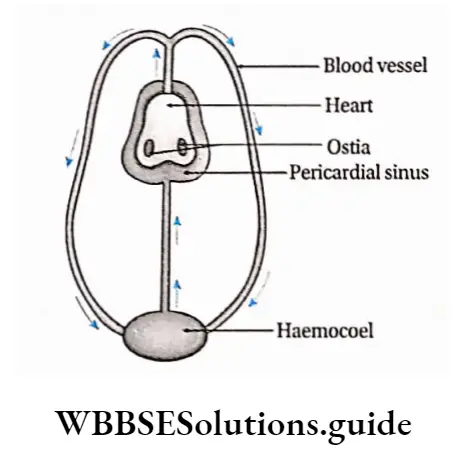
” human circulatory system diagram”
Examples: Open circulatory systems are found in animals such as arthropods, molluscs, and some other invertebrate groups.
Advantages of an open circulatory system:
- Direct exchange of gases, nutrients, and waste products takes place between the living cells of the organiser Hence, less amount of energy is required.
- Animals with an open circulatory system (with the exception of insects that carry out gaseous exchange independently from the circulation) are generally slower and have a low metabolic rate.
- Blood pressure remains low.
Disadvantage of open circulatory system
This system is not very effective, because fluid is pumped under low pressure, so it circulates slower than in a closed circulatory system.
“structure and function of circulatory system class 11 WBCHSE”
Closed Blood Circulatory System
The circulatory system in which the heart pumps the blood in the vessels, is called a closed blood circulatory system.
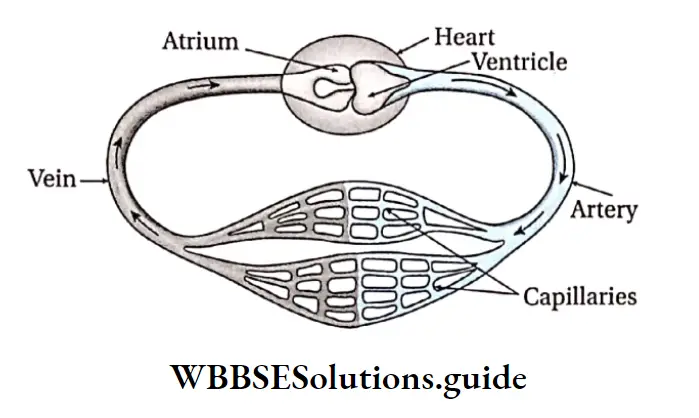
“human cardiovascular system diagram “
Lymphatic system
The lymphatic system is a network of tubular vessels or ducts and nodes through which lymph flows.
The lymphatic system is made up of the following structures—
Lymphatic capillaries: Lymphatic capillaries are tube-like structures. They have thin walls made of only a single layer of endothelial cells resting on a basement membrane.
They are closed at one end (blind end). They remain interwoven with blood capillaries but are not connected to them. They are wider than blood capillaries.
The lumens of these capillaries are filled with lymph and walls are permeable to interstitial fluid constituents, including protein Lymph vessels or lymph ducts Lymphatic capillaries join to form lymphatic vessels.
These vessels are structurally similar to the cardiovascular veins, though they have thinner walls and more valves. These valves prevent the backward flow of lymph as lymph flows toward the thoracic cavity.
Smaller lymphatic vessels unite to form larger lymphatic vessels. These larger vessels unite to form the two main lymphatic vessels or trunks.
“blood circulation process explained for WBCHSE students”
They are called the thoracic duct and the right lymphatic duct.
The thoracic duct receives lymph from the entire body The thoracic duct receives lymph from the entire body The thoracic duct receives lymph from the entire body lymphatic duct.
This duct joins to the left subclavian vein near the left side of the heart. The right lymphatic duct is present on the right side of the thoracic region. It collects lymph from the right hand, throat and thorax.
This duct opens into the right subclavian vein Cistema chyli: A small, dilated sac found near the lower area of the thoracic duct in the lumbar region of the body is called the cistema chyli or receptaculum chyli. It is part of the lymphatic system into which lymph from the intestinal trunk and two lumbar lymphatic trunks flow.
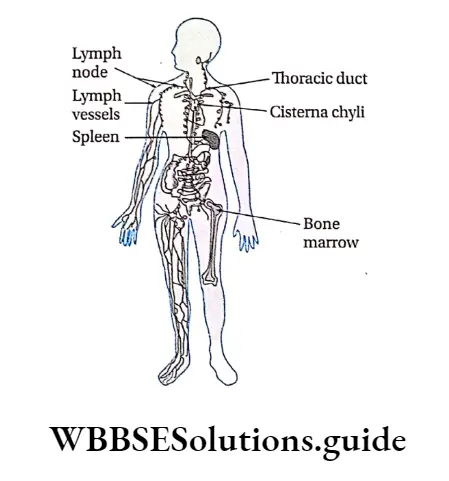
“heart, blood vessels, and circulation WBCHSE class 11 notes”
Lymph glands or lymph nodes: The lymph nodes are small bean-shaped structures that look like tiny bulbs and are found at intervals along the lymph vessels. They are masses of collagen and elastin fibres surrounded by a capsule made of fibrous tissue.
The afferent lymphatic vessels enter and efferent lymphatic vessels leave the lymphatic nodes.
Lymph nodes are especially abundant in specific regions such as armpits, neck and groins.
Axillary nodes, intercostal nodes, and inguinal nodes are some of the lymphatic nodes.
Besides these, some other glands such as the spleen, tonsils, etc., also consist of lymphatic tissues. The spleen is considered to be the largest lymphatic gland in the human body
“difference between systemic and pulmonary circulation WBCHSE”
Function Of Lymph Nodes
- Lymph nodes filter different foreign particles such as bacteria, etc., from the lymph.
- Lymphocytes are produced from the lymphoid cells present in the lymph glands. These lymphocytes are transported to the blood vessels through lymphatic vessels. They develop the immunity power of the body by producing antibodies.
- Several antitoxins and antibiotics are produced from lymph nodes. These substances destroy the toxins that enter our body.
Spleen
- It is the largest lymph gland present in our body. Some part of it is composed of lymphoid tissues.
- It is located between the diaphragm and the fundus region of the stomach.
“components of human circulatory system with diagrams”
Function of spleen
- Spleen is the graveyard of RBCs. The worn-out RBCs are phagocytised by the macrophages present in the spleen.
- It works as a blood reservoir as it can store some amount of RBCs during rest.
- Lymphocytes originate in the spleen.
- It produces antibodies and antitoxins.
WBCHSE Class 11 Biology Notes For Lymph
Lymph
Lymph Definition: The transparent, colourless or pale yellow tissue fluid that contains white blood cells (particularly modified lymphocytes) is called lymph.
“composition and role of lymph in human circulatory system”
This fluid circulates throughout the lymphatic system and returns to the venous blood by the thoracic and right lymphatic ducts. It transfers materials from blood to the body cells and vice versa.
“lymphatic system definition “

Origin: In arteries, blood flows at a higher pressure than in veins. Due to this, blood plasma filters out from the arterial capillaries and moves into the intercellular space to form interstitial fluid.
“WBCHSE class 11 biology notes for lymph”
This fluid contains water, glucose, amino acids, oxygen, carbon dioxide and several other electrolytes.
The exchange of different substances between blood and cells takes place via interstitial fluid.
Hence, its composition changes continuously. Some of this fluid is reabsorbed by the blood capillaries but most of it enters the lymph capillaries.
Read and Learn More Class 11 Biology Notes
This fluid collected inside the lymph capillaries is called lymph. At the time of formation, lymph is a clear watery liquid which has the same composition as that of interstitial fluid.

Composition Of Lymph
Lymph have a similar composition to blood plasma. Depending on the destination, lymph contains different concentrations of lymphocytes, proteins and fats. It has a large number of leucocytes (mostly lymphocytes) ranging from 500-75000/mm3. The lymph does not contain platelets.

“composition of lymphatic system “
The non-cellular portion of lymph contains water (94%) and solids (6%). The organic components of lymph include various proteins, fats, glucose and other non-protein nitrogenous substances urea, creatinine, enzymes, etc.).
“difference between blood and lymph class 11 WBCHSE notes”
Total protein content varies with the region from which the lymph drains. In fasting conditions fat content is low but after a fatty diet, it becomes higher. Inorganic components such as calcium, phosphorus, and chlorides are also present in lymph.
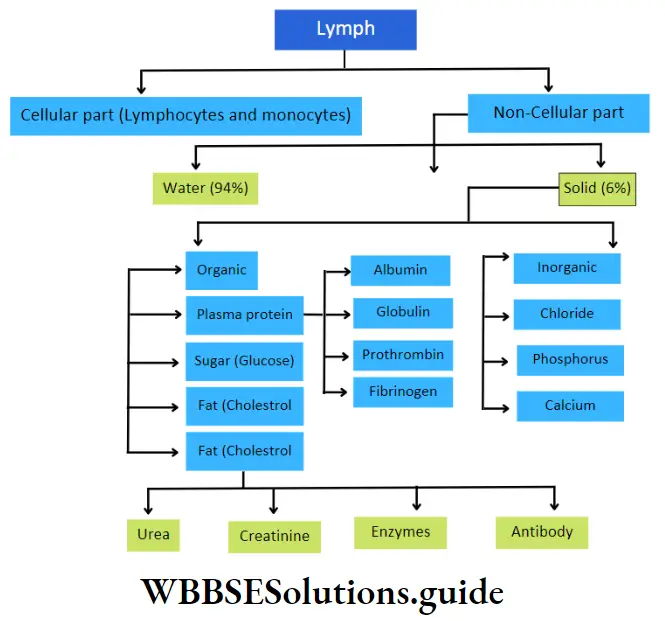
“lymph structure and function “
Functions Of Lymph
Transportation: Lymph is modified interstitial fluid, that is drained from the tissue and moved back to the circulatory system via the lymphatic network.
The lymphatic network transports important materials such as vitamins, digested food components, O2 etc., in the body. They also take away the waste products such as CO2, nitrogenous and non-nitrogenous wastes, etc., from the cells.
“detailed notes on lymph and its functions for WBCHSE class 11”
Removal of excess tissue fluid: Lymph returns protein and excess interstitial fluid to peripheral circulation.
Absorption: There are several small finger-like projections present on the inner wall of the small intestine, known as villi. Each of these villus consists of a lymphatic vessel, known as lacteal. Lacteal absorbs the digested fat and transports it to the bloodstream.
| Class 11 Biology | Class 11 Chemistry |
| Class 11 Chemistry | Class 11 Physics |
| Class 11 Biology MCQs | Class 11 Physics MCQs |
| Class 11 Biology | Class 11 Physics Notes |
“components of lymphatic system “
Disease prevention: The lymphatic system helps the body fight against diseases as the system contains a high concentration of lymphocytes in lymph nodes. The invading microorganisms and foreign particles are destroyed in the lymph nodes.
“structure and function of lymph nodes “
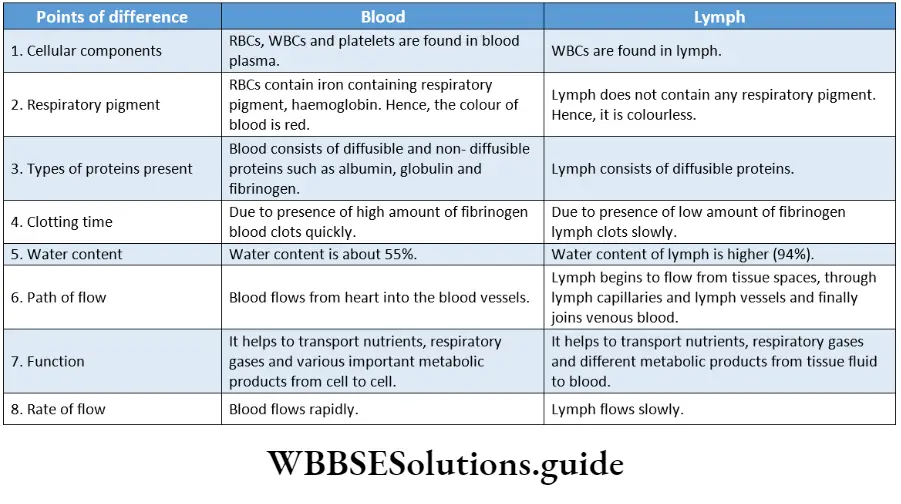
WBCHSE Class 11 Biology Notes For Human Circulatory System
Human Circulatory System
The human circulatory system consists of the muscular heart, the network of blood vessels and blood. Blood is the circulating fluid which flows through the blood vessels after being pumped by the heart.
Types: Two types of circulatory systems are found in human beings— blood and lymphatic systems.
Heart
The heart is the main organ of the circulatory system. In vertebrates, it is located on the ventral side of the oesophagus. The human heart is more complex and the Function of lymph nodes advanced as compared to other organisms.
Heart Definition: A multi-chambered muscular organ, that pumps blood throughout the body in a rhythmic process, is known as the heart.
” circulatory system questions”
Location: The heart is situated in between the lungs in the middle of the thoracic cavity, slightly tilted to the left. The heart rests on the superior surface of the diaphragm, posterior to the sternum.
Read and Learn More Class 11 Biology Notes
Shape and size: The size of the heart is closely related to the size of the organism’s body.
The base of the heart is broad and flat, about 9 cm in breadth. The length of the heart of an adult is about 10-12 cm. Externally, the heart appears as a cone-shaped structure.
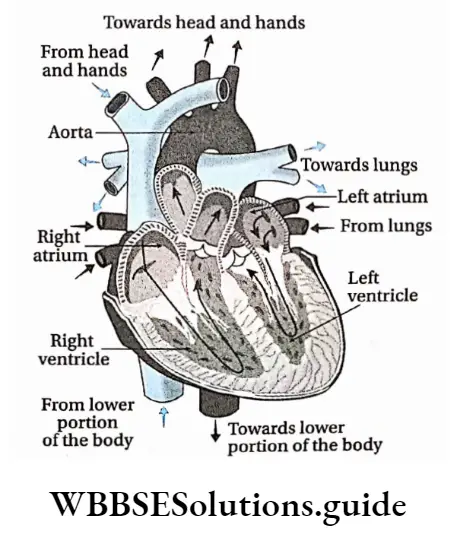
Shape and size: The size of the heart is closely related to the size of the organism’s body.
The base of the heart is broad and flat, about 9 cm in breadth. The length of the heart of an adult is about 10-12 cm. Externally, the heart appears as a cone-shaped structure
| Class 11 Biology | Class 11 Chemistry |
| Class 11 Chemistry | Class 11 Physics |
| Class 11 Biology MCQs | Class 11 Physics MCQs |
| Class 11 Biology | Class 11 Physics Notes |
Wall of the heart
The wall of the heart is composed of the following layers—
Pericardium: The heart is enclosed in a double-layered sac, called pericardium. It is the fibrous outer wall made of dense connective tissue.
The pericardium is further divided into two layers —
Fibrous pericardium: It is the outer fibrous transparent sac that covers the heart.
Serous pericardium: The inner side of the pericardium is formed of a serous layer and is known as serous pericardium.
This serous pericardium is again divided into two layers, the inner layer—visceral pericardium and the outer layer—the parietal pericardium.
“WBCHSE class 11 biology notes for human circulatory system”
Visceral Pericardium: This layer is also called the epicardium. It is the innermost layer of the pericardium. It is composed of a single sheet of squamous epithelial cells overlying delicate connective tissue. This layer adheres to the heart.
Parietal Pericardium: This layer lies between the visceral pericardium and the fibrous pericardium.

The pericardial cavity lies between the visceral pericardium and the parietal pericardium. This cavity is filled with pericardial fluid which serves as a shock absorber and reduces friction between the pericardial membranes.
” questions on circulatory system”
The primary function of the pericardium is to—
- Protect The Heart
- Anchor The Heart To The Surrounding Structures, Such As The Diaphragm And The Great Vessels; And
- Prevent The Heart From Overfilling.
Myocardium: The myocardium is a thick contractile layer present just below the visceral pericardium.
It is composed of muscle cells, known as myocardiocytes. This layer is more thick in the ventricles than in the atria. This layer of the left ventricle is thicker than the right ventricle.
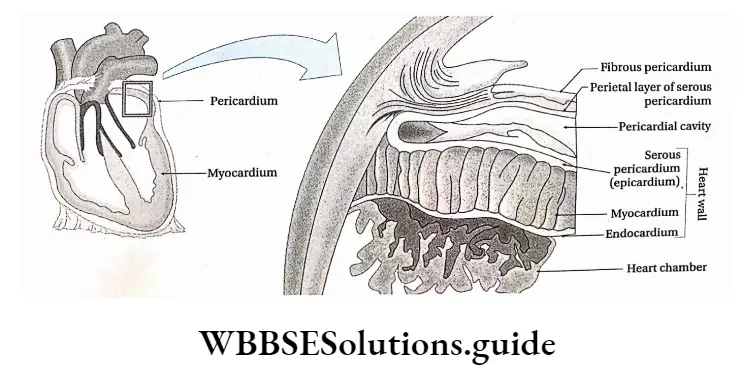
Endocardium: The endocardium is the innermost layer of the heart wall and lines the heart’s chambers.
It is made of squamous epithelium that rests on a thin connective tissue layer. It is continuous with the endothelium of the great blood vessels—the inferior and superior vena cava.
Chambers Of The Heart
The heart is a hollow, four-chambered, muscular organ that consists of the upper right and left atria (singular: atrium) and the lower right and left ventricles.
The atria are separated by a thin muscular wall called the interatrial septum and the ventricles are separated by a thick muscular wall called the interventricular septum.
There is a translucent, depression present in the septum between the right and left atrium, known as fossa ovalis. In the embryonic stage, there is an opening in place of the fossa ovalis.
It is known as foramen ovale. The heart actually functions as two separate pumps.
“detailed notes on human circulatory system for class 11 WBCHSE”
The right atrium and ventricle act as one pump to propel deoxygenated blood to the lungs. At the same time, the left atrium and ventricle act as another pump to propel oxygenated blood collected from the lungs towards the heart throughout the systemic circulation.
” body fluids and circulation bank of biology”
The right atrium and right ventricle: The inner surfaces of both atria are mostly smooth except for a low network of muscular ridges called musculi pectinati. The right atrium receives deoxygenated blood through the openings of the superior vena cava, inferior vena cava & coronary sinus.
The right atrium is connected to the right ventricle through an opening, known as the right atrioventricular orifice or aperture.
The right atrioventricular orifice is guarded by the right atrioventricular valve or tricuspid (formed of three flaps or cusps) valve.
This valve regulates unidirectional blood flow from the right atrium to the right ventricle and prevents the backflow of blood.
There are numerous muscular ridges on the inner wall of the right ventricle, known as columnae carneae.
They contain some finger-like muscular projections, known as papillary muscles. The cusps or leaflets of the tricuspid valve are attached to the wall of the right ventricle by strong, elastic threads, known as chordae tendineae. The opening and closing of the tricuspid valve are controlled by the papillary muscles through the chordae tendineae.
The pulmonary artery originates from the right ventricle. There is a seminular valve present at the juncture of the pulmonary artery and right ventricle.
Left atrium and left ventricle: The left atrium and left ventricle are also connected to each other through an opening known as the left atrioventricular orifice or aperture.
“structure and function of human circulatory system notes”
The left atrioventricular orifice is guarded by the bicuspid (formed of two cusps) or mitral valve.
The left atrium receives four pulmonary veins, two from the left and two from the right lung.
These pulmonary veins bring oxygenated blood from the lungs. They do not have any valve to regulate the blood flow. Blood flows obliquely from the atrium to the ventricle which is regulated by the mitral valve.
The left ventricle which is larger than the right ventricle, has much thicker walls. Like the right ventricle, it also possesses columnae carneae and papillary muscles. Chordae tendineae are also seen.
The lower part of the left ventricle receives blood from the left atrium. The upper part, which has mainly fibrous walls, is termed the aortic vestibule, and it ends in the aorta, the largest artery of the body.
The junction of the vestibule and aorta contains dense fibrous tissue that encircles the aortic valve and is continuous with the cardiac skeleton.

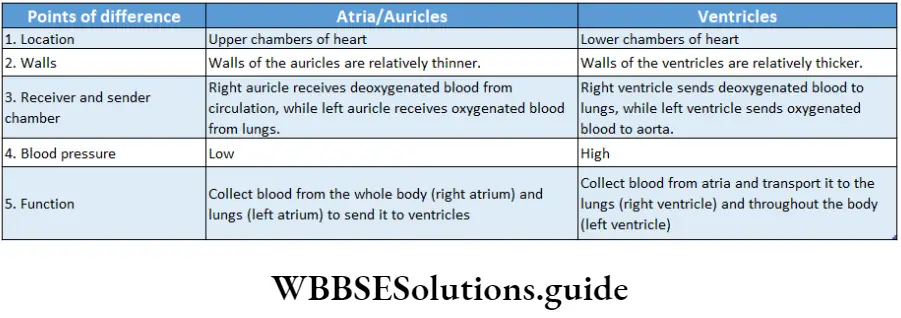
mcq on body fluids and circulation pdf
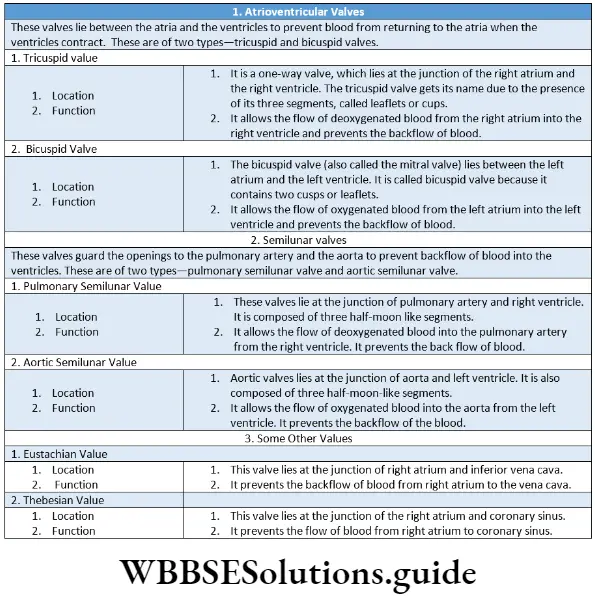
Cardiac grooves
- All the different chambers of the heart are separated from each other by grooves. These grooves are known as cardiac grooves.
- The left and right atria are separated from each other by an interatrial groove. Atria and ventricles are separated from each other by the coronary sulcus or atrioventricular groove.
- The grooves by which two ventricles are separated from each other are known as anterior interventricular sulcus and posterior interventricular sulcus.
Junctional Tissues Of Heart
Junctional Tissues Of Heart Definition: The tissues of the cardiac muscles, responsible for the origin and conduction of cardiac impulses (waves of electric potential generated by stimulation of cardiac muscles by specific stimulus), are known as junctional tissues of the heart.
Junctional Tissues Of Heart Types:
- Sino-atrial (SA) Node,
- Atrioventricular (AV) node,
- Bundle of His,
- Purkinje fibres,
- Internodal tract.
- Sinoatrial (SA) node
Location: Situated on the right wall of the right atrium, near the entrance of the superior vena cava.
Characteristics: The SA node is a small mass of muscle tissue, about 3.0 mm in width.
“blood circulation process explained for WBCHSE class 11”
Function: This is known as the “Natural Pacemaker” or heartbeat regulator. It initiates impulses automatically at a more rapid rate than any other
part of the conduction system.
Its rate of discharge of impulses determines the rate of heartbeat. The electrical signal spreads out over the walls of the atria, causing them to contract.
Atrioventricuiar (AV) node
Location: It is located in the right posterior portion of the interatrial septum.
Characteristics: Muscles of AV nodes are cardiac muscle fibres. It contains a very small amount of myofibrils.
AV muscle fibres are comparatively smaller than the SA node. The AV node and the conduction tissue surrounding it are known as the AV junctional tissue.
The AV node is also called the ‘reserve pacemaker of heart’ because during functional inactivity of the SA node, it can initiate heartbeats, but at a slower rate.
Function: The action potential spreading through the right atrium causes depolarization of the AV node.
When the impulses reach the AV node, there is a slight delay that allows the atria to finish their contraction before the ventricles begin their contraction.
The AV node then conducts impulses to the muscles of the ventricles through a bundle of His and Purkinje fibres.
Bundle of His and its branches
Location: It is a band of nerve fibres that originates from the posterior part of the AV node, and then passes along the interventricular septum to the ventricles.
Characteristics: A Swiss physician, Wilhelm His, first described this tissue. It divides into right and left branches which proceed along the right and left sides of the interventricular septum to the tips of the two ventricles. It is also called an AV bundle.
Function: These specialised fibres conduct the impulses at a very rapid velocity (about 2 m/sec). The bundle of His constitute the only electrical link between the atria and the ventricles.
Purkinje fibres
Location: The Purkinje fibres, named after their discoverer Johannes von Purkinje, are the tree-like terminal branchings of right and left bundles of His.
Characteristics: Cells of these fibres consist of high amount of glycogen-contining sarcoplasm. There are thousands of myofibrils present around the cells.
“heart structure and working class 11 biology WBCHSE notes”
Function: Purkinje fibres conduct the impulses at high velocity (about 4 m/sec) throughout the ventricles. During the ventricular contraction, they carry the impulses from both the left and right branches of the bundle of His to the myocardium of the ventricle.

Internodal tract
Location: These are located between the SA node and the AV node.
Characteristics: There are three internodal tracts connecting the SA node and AV node—the anterior tract of Bachman, a middle tract of Wenckebach and the posterior tract of Thorel.
Function: Their main function is to carry impulses from the SA node through the right atrium to the AV node.
As the impulses pass along the internodal tracts, the right atrium contracts, pushing the blood it contains, through the tricuspid valve into the right ventricle.
Myocardial tissue has four main characteristics that integrate the heart’s electrical and mechanical activity
“short notes on human circulatory system for WBCHSE board exams”
Automaticity: It is the ability to initiate an impulse or stimulus. The pacemaker cells (SA node) of the cardiac conduction system spontaneously depolarize in the absence of external stimulation. The AV-junctional tissue and the His-Purkinje network also possess the property of automaticity.
Excitability: It is the ability to respond to an impulse or stimulus. The cells are electrically irritable because of an ionic imbalance across the cell membranes.
Cells thus respond to external stimuli from chemical, mechanical or electrical sources. Atrial and ventricular myocardial fibres respond to the impulse generated by the pacemaker cells of the cardiac conduction system by depolarization and repolarization.
Conductivity: It is the ability to transmit impulses to other areas of the heart. Cells of the conduction system and the myocardial muscle fibres, both have this property.
“difference between systemic and pulmonary circulation notes”
Contractility: It is the ability of cardiac muscles to shorten, responding to stimuli with mechanical action. Myocardial fibres respond mechanically to electrical stimulation by contracting.
The course of circulation of blood through the human heart The circulation of blood through the human heart occurs through periodic systole and diastole.
They are discussed below—
Atrial diastole: This is the relaxation time of both the atria. During this time deoxygenated blood enters into the right atrium through superior and inferior vena cava and oxygenated blood from the lungs enters into the left atrium through pulmonary veins.
The mixing of the blood is prevented due to the presence of an interatrial septum between the atria.
Auricular or atrial systole: This is contraction time for both atria. The deoxygenated and oxygenated blood move from the right and left atria respectively to the corresponding ventricles.
“composition of blood and its function in circulation notes”
The tricuspid and bicuspid valves present at the atrioventricular grooves open to guide the flow of blood.
Ventricular diastole: This is the relaxation time of the ventricles. During this time, the left ventricle receives oxygenated blood from the left atrium and the right ventricle receives deoxygenated blood from the right atrium.
Ventricular systole: It is the time for contraction of both the ventricles. The deoxygenated blood in the right ventricle flows to the lungs through the pulmonary artery.
“important points on blood vessels and circulation for WBCHSE”
The oxygenated blood from the left ventricle flows to different parts of the body through the aorta.
The bicuspid and tricuspid valves close during this time and prevent the backflow of the blood to the atria. At the same time the semilunar valves open and guide the blood flow to the respective blood vessels and prevent the backflow of the blood to the ventricles.
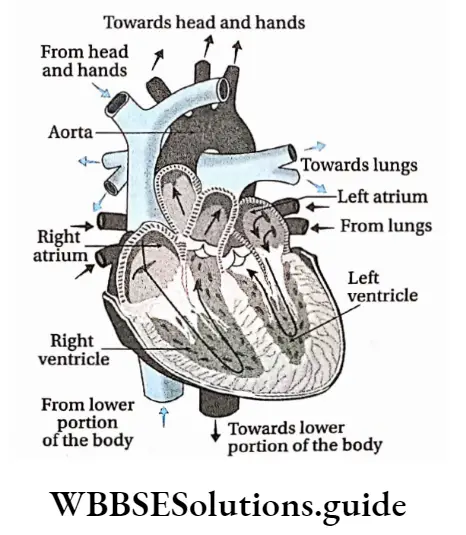
WBCHSE Notes For Class 11 Biology Erythopoietin
Erythropoietin
It is a glycoprotein hormone which controls erythropoiesis. It is produced in the interstitial fibroblast cells closely associated with peritubular capillary and proximal convoluted tubule in the kidney (90%), liver and other organiser:
Rouleaux formation
Sometimes RBCs are stacked on each other and form a structure like stacked dinner plates. This condition is known as rouleaux formation.
These stacked structures can move easily through broad blood vessels but cannot move through narrow blood vessels, and sometimes become barriers in blood circulation.

erythropoietin definition
Site of rupture: After completing their lifespan, RBC rupture in the liver and spleen. The spleen is known as the graveyard of RBC.
Haemolysis and fate of RBCs: At the end of their lifespan, the plasma membrane of the RBC ruptures and releases their content including haemoglobin in the surrounding fluid. This process is known as haemolysis.
“WBCHSE class 11 biology notes for erythropoietin”
Functions of RBC: These are as follows—
Transportation of O2 and CO2: RBCs collect oxygen from the lungs and release it to the cells and tissues.
They take up carbon dioxide from the cells and tissues and release it to the lungs.
| Class 11 Biology | Class 11 Chemistry |
| Class 11 Chemistry | Class 11 Physics |
| Class 11 Biology MCQs | Class 11 Physics MCQs |
| Class 11 Biology | Class 11 Physics Notes |
erythropoietin meaning
Haemoglobin found in the red blood cells helps in the transport of oxygen and carbon dioxide between the lungs and the cells.
Regulation of acid-base balance: Haemoglobin present in RBC acts as a buffer and regulates the carbonate ion concentration.
Regulation of viscosity of blood: RBCs help to regulate the viscosity of the blood.
Maintenance of ionic balance: In the RBCs, carbon dioxide either binds to haemoglobin or reacts with water.
In reaction with water, it produces carbonic acid, which when dissociates, produces hydrogen ions. The deoxygenated haemoglobin is a stronger base and is capable of taking up these hydrogen ions. Hence, they are buffered by haemoglobin.
Other functions: RBCs carry the blood group antigens and Rh factor.
Erythrocyte sedimentation rate (ESR) The erythrocyte sedimentation rate (ESR) is the rate at which red blood cells settle down in a tube containing blood under standardized conditions and is a measure of inflammation or abnormal proteins in the body.
ESR commonly increases with any condition that gives rise to inflammation, such as infection, arthritis, or cancer.
“detailed notes on erythropoietin and its function WBCHSE”
It plays a very important role in the detection of any disease. According to the Wintrobe method, the normal ESR value is 0-9mm/h for males and 0-20mm/h for female
Haemoglobin: The red, oxygen-carrying, iron-containing pigment, comprising of a haem group and globin protein, that is found in the red blood cells of vertebrates is called haemoglobin.
Structure of haemoglobin: Haemoglobin (Hb) is a molecule made up of four subunits. Each subunit contains a haem moiety conjugated to a polypeptide. There are two pairs of polypeptides in each haemoglobin molecule.
Haem is an iron-containing porphyrin derivative. The polypeptides are collectively referred to as globin.
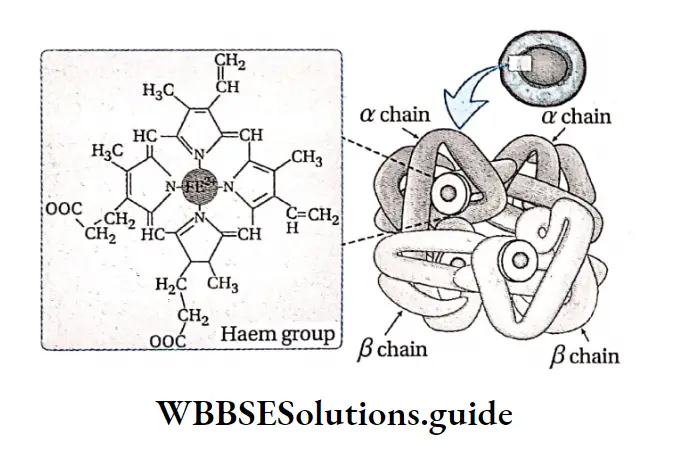
“role of erythropoietin in red blood cell production”
Instruments for measuring haemoglobin
The concentration of haemoglobin can be measured by using different instruments and methods. This includes Helden’s haemoglobinometer and Gauhar’s haemoglobinometer. Nowadays, a spectrophotometer is used to measure the concentration of haemoglobin.

RBC ghost
After hypotonic haemolysis of RBCs, all the cytoplasm along with the haemoglobin comes out from the cells. If these cells are observed under a microscope, then a spectrin-rich endoskeleton is found in these cells. These cells are known as RBC ghosts.
Location: Haemoglobin is found in the RBCs of human beings and other vertebrates.
Types: Normally there are two types of haemoglobin found in human beings, these include
HbA and HbF.
HbA: HbA (Adult haemoglobin) is found in adult human beings. It has 2 alpha and 2 beta polypeptide chains and comprises 97% of normal adult haemoglobin.
HbA is again of two types: HbA2 and HbA2 The globin portion of HbA-! consists of four polypeptide chains—2ar chains and 2/3 chains.
Each chain contains 141 amino acid molecules. Each chain contains 146 amino acid molecules.
Thus, HbA is designated as α2δ2. Not all the haemoglobin in the blood of normal adults is HbA HbA2 consists of two a and two 6 chains.
Thus, HbA2 is designated as α2δ2. The β chains also contain 146 amino acid molecules, but 10 individual residues differ from those in the chains.
hormone erythropoietin
About 98% of the total haemoglobin in adults is HbAi and 2-2.5% is HbA2.
HbF: HbF is normal foetal haemoglobin. It has 2 alpha and 2 gamma polypeptide chains mainly found in the embryonic stage.
“mechanism of erythropoiesis regulated by erythropoietin”
Variants of normal haemoglobin are formed when there are genetic changes in the globin genes.
Amount: The amount of haemoglobin present in 100 ml of blood is 14-17g in healthy adult males and 12-16g in healthy adult females.
Chemical nature: Haemoglobin is formed of iron-containing pigment haem (4%) and globin protein (96%). Haem consists of Fe2+ or ferrous ions in the centre of heterocyclic organic compounds, called porphyrins.
The molecular weight of haemoglobin is 68000 Da.
Fate of haemoglobin: Old RBCs are destroyed by the macrophages. Breakdown of haemoglobin occurs by the action of the enzyme haem oxygenase.
This generates haem and globin molecules. The haem is then converted to bilirubin and biliverdin. These pigments get released in the bile. The iron group of the haem portion is reused in the formation of haemoglobin.
Functions of haemoglobin: The functions of haemoglobin are discussed below.
“importance of erythropoietin in blood formation class 11 WBCHSE”
Helps to transport respiratory gases: During respiration in vertebrates and in higher animals, the inhaled oxygen combines with haemoglobin to form oxyhaemoglobin. This oxyhaemoglobin moves through blood capillaries and reaches the tissues.
Similarly, the carbon dioxide produced in the tissues combines with haemoglobin and form carbaminohaemoglobin, which reaches the alveoli of the lungs through the blood capillaries.
In this way, haemoglobin helps in the transportation of oxygen and carbon dioxide.
Maintains the acid-base balance in blood: Haemoglobin acts as a buffer and maintains the acid-base balance of the body.
Produces pigment materials: The haemoglobin found in dead RBCs forms pigments such as biliverdin, bilirubin, sercobilinogen, etc.
These give colour to the faeces. Haemoglobin also produces the pigment urochrome, which gives a straw colour to the urine.
White Blood Corpuscle or Leucocyte or WBC
White Blood Corpuscle or Leucocyte or WBC Definition: White blood cells (WBCs) are colourless nucleated blood cells which lack haemoglobin and participate in reactions against invading pathogens or foreign particles in the body.
Structural characteristics:
- WBC do not contain any pigment so, they are colourless.
- They contain cytoplasm and a persistent nucleus. The cytoplasm of WBC can be granular or smooth (agranular). The nucleus can be of different shapes, such as spherical, kidney-shaped, etc.
- All the white blood cells are capable of amoeboid movement.
- WBCs are rich in nucleoprotein. Their cytoplasm consists of lipids, glycogen, cholesterol, vitamin C and different enzymes.
- Mitochondria, Golgi apparatus and other organelles are present in the cytoplasm of WBCs.
Size: WBCs do not have a fixed diameter. Their average diameter is 8-18 pm.
Lifespan: The average lifespan of WBC is 1-15 days.
Number: The total WBC count is normally about 4,000 – 11,000 per mm3 of blood.
Origin of WBC: WBC originates in bone marrow, spleen and lymph nodes. White blood cells are produced from pluripotent haemopoietic stem cells—myeloblast, lymphoblast and monoblast.
Types: Depending on the presence and absence of granules in the cytoplasm, WBCs are categorised into two main groups— Granulocytes (including neutrophils, eosinophils and basophils) and Agranulocytes (including lymphocytes and monocytes).
This classification depends on whether granules can be distinguished in their cytoplasm using a light microscope and conventional staining methods. WBCs can also be divided into two broad groups—the phagocytes and the immunocytes.
“how erythropoietin is produced and its effects on the body”
Granulocytes, which include three types of cells— neutrophils, eosinophils and basophils, together with monocytes comprise the phagocytes.
The lymphocytes, their precursor cells and plasma cells make up the immunocyte population. The types of WBCs (granulocytes and agranulocytes) are discussed under separate heads.
Granulocytes: The white blood cells that contain granules in their cytoplasm are known as granulocytes.
According to the characteristics of granules, granulocytes are categorised into three types— neutrophil, eosinophil and basophil.
The granulocytes have lobed nuclei which have varying shapes from cell to cell. Hence granulocytes are also known as polymorphonuclear leucocytes.
Neutrophil: The granular WBCs which can be stained with neutral stain are called neutrophils.
Structural features:
The cytoplasm of the neutrophils consists of numerous granules and they can be stained with neutral stain. They get stained with both basic (methylene blue) and acidic (eosin) dyes. Hence, they appear purple in colour.
- The nucleus appears purple due to staining and is divided into two to five segments or lobes.
- The lobes are divided into two to five segments or lobes.
- The lobes are connected by a thin strand or filament of nuclear material,
Neutrophils have 3 types of granules—
- Azurophilic or primary granules,
- Specific or secondary granules,
- Gelatinase-containing granules or tertiary granules.
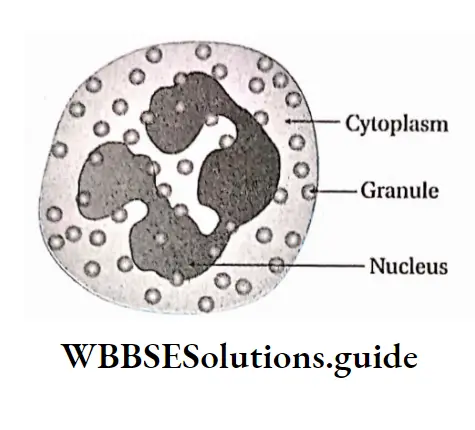
Diameter: 10-12 pm
Lifespan: A few hours to a few days (2-4 days).
Number: Neutrophils are the most abundant type of WBCs in our body. They make up 50-70% of the total amount of WBCs. There are about 3000-6000 neutrophils present per mm3 of blood.
Functions: Neutrophils act as the first line of defence against pathogens. They are motile and phagocytic (destroy damaged tissues). They contain enzymes like protease, elastase, metalloproteinase, NADPH oxidase and antibody-like substances, defensins.
These antimicrobial peptides are active against bacteria and fungi. They secrete Platelet Aggregation Factor (PAF) which accelerates the aggregation of platelets at the injured site of blood vessels.
Reasons for the increase in the neutrophil count
The following reasons are responsible for the increase in the neutrophil count—
- Infection,
- Destruction of cells and tissues due to burns, myocardial infarction, etc., © leukaemia,
- Excess smoking, taking contraceptive pills, etc.
Eosinophil: The granulated WBCs where the granules can be stained with acidic dye (eosin) are known as eosinophils.
- Structural features:
- Usually, eosinophils have a bilobed nucleus. The cytoplasm is packed with large, coarse, retractile, orange-red granules containing histamine. The granules are referred to as eosinophilic because they take up the acidic dye, eosin.
- Eosinophils are produced in the bone marrow and circulate in the bloodstream for about 6 hours before migrating to the tissues.
- Diameter: 10-12 pm
- Lifespan: A few days (8-12 days).
- Number: There are 150-300 eosinophils per mm3 of blood. They constitute about 1-4% of the total WBCs.
- Functions:
- Eosinophils respond to chemotactic stimuli and are phagocytic. They can kill ingested organisms,
- Eosinophils also take part in allergic reactions. They also produce histaminase and aryl sulphatase B. These are the enzymes that inactivate two inflammatory agents released by mast cells,
- Eosinophils take part in dissolving blood clots in blood vessels.
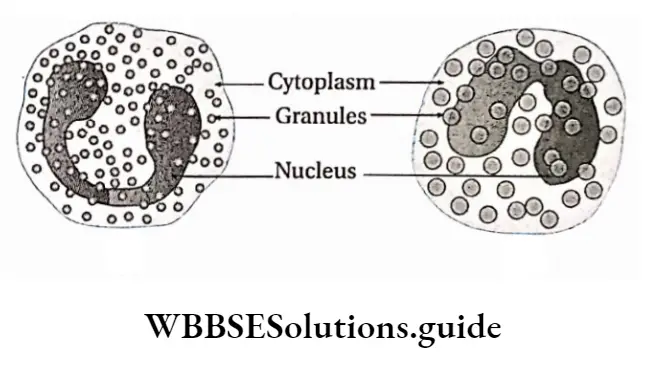
Basophil: The granular WBCs where the granules are stained with basic dyes (methylene blue) are known as basophils.
- Structural features:
- The nucleus of basophil is 2-3 lobed. The cytoplasm has fewer number of coarse granules,
- The granules are called basophilic because they take up basic stains (such as methylene blue). Upon staining the granules take up bluish purple color against pale blue cytoplasm.
- Diameter: 8-10 pm.
- Lifespan: 12-15 days.
- Number: They are the rarest type of white blood cell, making up only 0.4% of the total white blood cells, found in a blood smear. 0-100 basophils are present per mm3 of blood.
- Functions: They have a role in allergic and inflammatory responses.
Basophil granules release some important substances such as—
- Proteases: Exaggerate inflammation,
- Hyaluronic acid: Necessary for deposition of ground substances in the basement membrane,
- Heparin: Prevents intravascular blood clotting,
- Histamine: Mediate’s acute hypersensitivity reaction—vascular changes, increased capillary permeability
- Serotonin: Acts as vasoconstrictor.
Agranulocytes: The white blood cells that do not have any granules in their cytoplasm are known as agranulocytes.
“short notes on erythropoietin for WBCHSE board exams”
Agranulocytes are mainly of two types—
- Monocytes and
- Lymphocytes.
Monocyte: The large agranulated cells, capable of phagocytosis are known as monocytes.
- Structural features:
- Monocytes are amoeboid in appearance. The nucleus is round or oval-shaped when cells are young.
- But as they grow older, the nucleus becomes convoluted, kidney-shaped or horse-shoe-shaped.
- The cells have a large amount of dear non-granular cytoplasm, maybe, with vacuoles in it.
- These cells are mainly formed in the bone marrow.
- Diameter: About 16 – 18 pm in diameter.
- Lifespan: About 2-4 days.
- Number: 300-600 monocytes per mm3 of blood.
- Functions:
- Monocytes in the circulation are precursors of tissue macrophages that are actively phagocytic.
- Monocytes circulate in the blood for 1-3 days and then migrate to body tissues, where they transform into macrophages.
- They destroy dead cells and bacteria by the process of phagocytosis,
- They secrete some signalling proteins like interleukin 1 (IL-1), which increase the body temperature during infections and help in the production of T-lymphocytes.
“clinical significance of erythropoietin in anemia treatment”
Lymphocyte: The granulated white blood cells which produce antibodies are known as lymphocytes.
- Structural features:
- Lymphocytes form an essential component of the immune system and are derived from haemopoietic stem cells.
- On the basis of nuclear size, the lymphocytes are of two types. These are—
- Small lymphocytes: These are more common in normal blood. They have a large, dense, round nucleus which occupies the major portion of the cell.
- Large lymphocyte: The nucleus may be round and indented. The cytoplasm is basophilic and thicker than that of the small lymphocyte and forms a wider zone around the nucleus.
- Diameter: A small lymphocyte is slightly larger than a red blood cell and the diameter is about 7.5pm. The diameter of large lymphocytes is about 12 p.m.
- Lifespan: About 2-3 days.
- Number: These are the second most common WBC (25-35%), and are easy to find in blood smears 1500-4000 lymphocytes are present per mm3 of blood.
- Functions:
- They produce immunoglobulins or antibodies,
- Lymphocytes are mainly concerned with the production and transport of antibodies and they take an active part in the response to a wide range of antigens,
- They attack viruses, cancer cells, etc.
- Certain lymphocytes are part of the generalised response of the innate immune system, responding quickly to threats. Others act against specific pathogens or infected cells and are part of the adaptive immune response,
- Lymphocytes of the adaptive immune system are specific to a particular antigen—substances foreign to the body
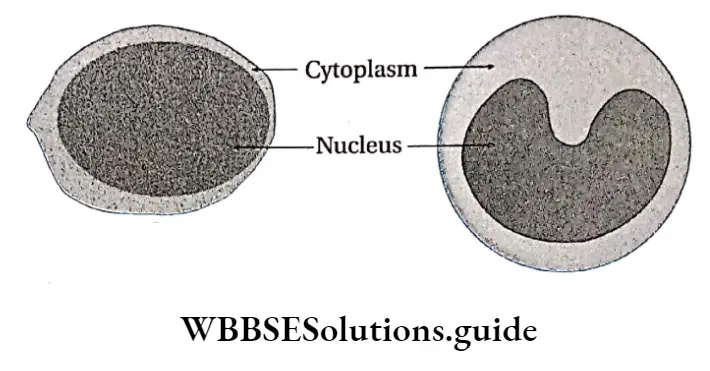
General functions of WBCs
- Destruction of germs: The neutrophils and monocytes destroy the ingested pathogens and foreign materials by phagocytosis. They help to protect the body from harmful agents.
- Production of antibodies: The lymphocytes increase the defensive mechanism of the body by producing antibodies.
- Prevention of allergies: Eosinophils play an important role in allergic reactions by producing histamine.
- Secretion of heparin: Basophils prevent intravascular blood coagulation by secreting heparin.
- Trephone production: From plasma proteins, the monocytes produce a chemical substance, known as trephone. It provides nourishment to the tissues.
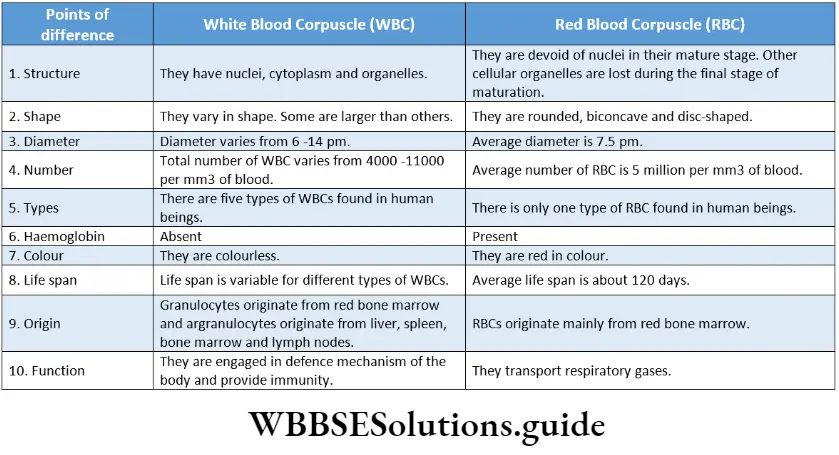
Thrombocyte Or Platelet
Definition: Platelets or thrombocytes are small, granulated and anucleated blood corpuscles, which are involved in blood clotting. (Greek. Thrombos= lump or clot and cyta= vessel; the word cute is derived from it and used to name these cells)
Platelets are membrane-bound fragments of cells that form when larger cells in the bone marrow break apart. Platelets do not contain nuclei and help in coagulation and clotting of blood at the wound.
Structural features:
- Platelets are actually not true cells but merely circulating fragments of cells.
- They are non-nucleated, round or oval, plate or disc-shaped structures, which is the reason behind their nomenclature.
- Platelets are formed from the terminal end of the pseudopodia of megakaryocytes (large bone marrow cells will lobed nuclei).
- They are surrounded by selectively permeable membranes.
- They appear somewhat smaller in the microscope. This is because their cytoplasm is divided into two zones—an outer hyalomere, which hardly stains, and an inner granulomere, which contains granules, that appear bluish in colour when stained.
Size: The mean diameter of platelets varies in different individuals, ranging from approximately 2-4 m.
Lifespan: These break down in the blood within 7 to 10 days after their formation.
Number: The platelet count in the circulating blood is normally between 2,00,000 and 5,00,000 per mm3 of blood. Newborn babies have a slightly lower level of platelets, which normally attain the adult range within three months from birth.
“difference between erythropoietin and other blood growth factors”
Functions: These are as follows—
Blood clotting and coagulation: Platelets play a key role in blood clotting, which prevents excessive blood loss after an injury.
Storage of important biomolecules: Platelets also act as the storage for several substances, including serotonin, epinephrine, histamine, and thromboxane and also help in their transportation.
Repairing of wounds: Upon activation, they release specific molecules which initiate constriction of local blood vessels, which facilitates clot formation.
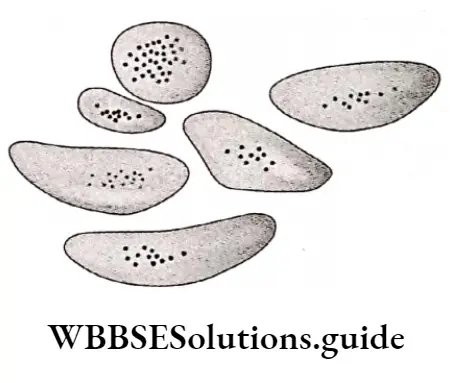
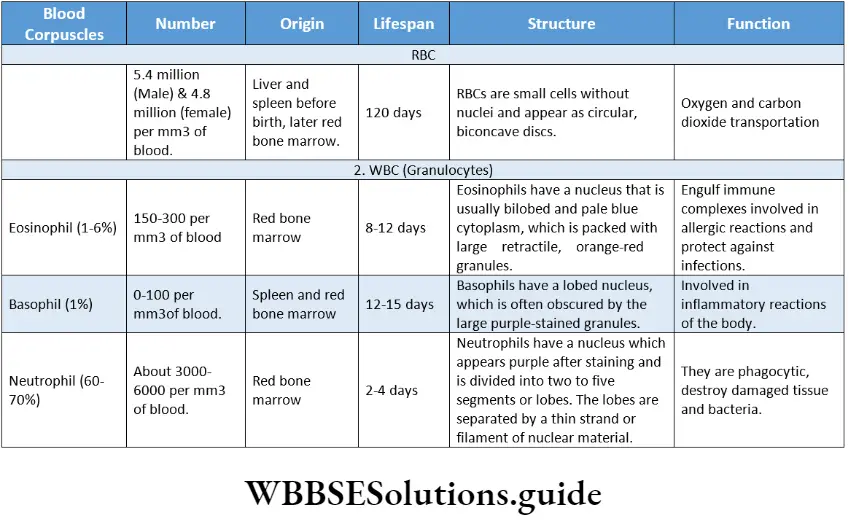
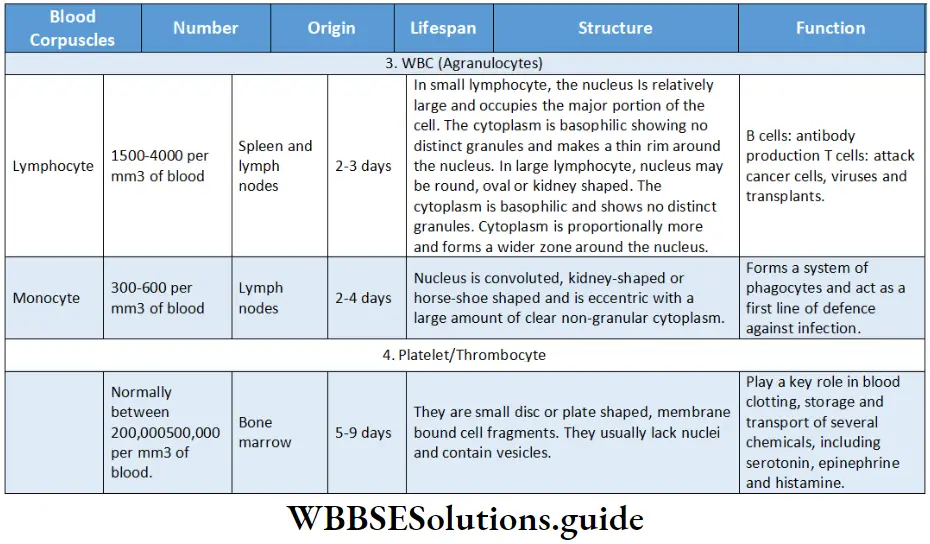
WBBSE Class 10 Physical Science Chapter 2 Behaviour Of Gases Multiple Choice Questions
Chapter 2 Behaviour Of Gases MCQs
Question 1. In the ideal gas equation PV = nRT, the value of R depends upon :
- Unit of measurement
- Temperature of gas
- Pressure of gas
- Nature of gas
Answer: 1. Unit of measurement.
Question 2. An ideal gas is one which :
- Obeys gas laws
- Obeys Boyle’s law
- obeys Chaple’s law
- Avogadro’s law
Answer: 1. Obeys gas laws.
“WBBSE Class 10 Physical Science Chapter 2 multiple choice questions, Behaviour of Gases”
Question 3. The volume of any gas at this temperatur becomes zero :
- + 273°C
- – 273°C
- 273K
- 273K
Answer: 2. -273°C.
Question 4. P1 V1 = P2 V2 , is related to:
- Boyle’s law
- Charle’s law
- Regnault’s law
- None of these
Answer: 1. Boyle’s law.
WBBSE Class 10 Physical Science Question Answer In English
Question 5. Normal pressure is :
- 1.013 x 106 dyne/cm2
- 2.013 x 106 dyne/cm2
- 1.05 x 10% dyne/cm2
- 1.09 x 106 dyne/cm2
Answer: 1. 1.013 × 10% dyne/cm2

Question 6. The relation between the pressure, temperature and density of a gas is:
- \(\frac{\mathrm{PT}}{\mathrm{D}}=\text { constant }\)
- \(\frac{\mathrm{P}}{\mathrm{DT}}=\text { constant }\)
- \(\frac{P D}{T}=\text { constant }\)
- None of these
Answer: 2. \(\frac{\mathrm{P}}{\mathrm{DT}}=\text { constant }\)
“Class 10 WBBSE Physical Science Chapter 2 multiple choice questions, Behaviour of Gases study material”
Question 7. What will be the value of 127°C on the kelvin scale?
- 127K
- 400K
- 146 K
- 200 K
Answer: 2. 400K.
Question 8. The relation between Celsius and absolute scale is :
- T = t + 273
- T = t – 273
- t=T+273
- t = T 273
Answer: 1. T t + 273.
“WBBSE Class 10 Physical Science Chapter 2, Behaviour of Gases MCQs”
Question 9. The boiling point of water in the Kelvin scale is :
- OK
- 373 K
- 100 K
- 273 K
Answer: 2. 373 K.
Question 10. For the liquefaction of gas, the favourable conditions are :
- low temperature and low pressure
- low temperature and a catalyst
- low temperature and high pressure
- low temperature, high pressure and a catalyst
Answer: 2. low temperature and high pressure.
Question 11. The pressure of real gases is less than the pressure of an ideal gas because of:
- Increase in the number of collisions
- Finite-size of the molecules
- Increase in kinetic energy
- Intermolecular forces
Answer: 4. Intermolecular forces.
Question 12. P, V, and T stand for the pressure, volume and temperature of a gas. Which of the following will express Boyle’s law?
- V x T when P is constant
- \(V \times \frac{1}{P} \text { when } T \text { is constant }\)
- PV = RT
- PV = nRT
Answer: 2. \(V \times \frac{1}{P} \text { when } T \text { is constant }\)
Question 13. The number of gram molecules of oxygen is 6.02 × 1024 Co molecules is:
- 8g molecules
- 5g molecules
- 2g molecules
- 0.5g molecules
Answer: 2. 5g molecules.
Question 14. The volume of 4.4g of CO2 at STP is
- 22.4
- 2.24L
- 224 L
- 44.8 L
Answer: 2. 2.24L.
Question 15. The kinetic theory of gases proves :
- Only Boyle’s law
- Only Charles’ law
- Only Avogadro’s law
- All of these
Answer: 4. all of these.
Question 16. Gas deviates from ideal gas nature because of molecules :
- Are colourless
- Attract each other
- Contain covalent band
- Show Brownian movement
Answer: 2. attract each other.
Question 17. One of the following is not the postulate of the kinetic theory of gases :
- The actual volume of the molecules is negligible compared to the volume of the gas.
- The molecules remain in ceaseless motion.
- There are sufficient attractive forces between the molecules.
- The average kinetic energy of the gas molecules is directly proportional to the absolute temperature.
Answer: 3. There are sufficient attractive forces between the molecules.
“WBBSE Class 10 Behaviour of Gases multiple choice questions, Physical Science Chapter 2”
Question 18. The critical temperature of a gas is the temperature :
- Below which it cannot be liquefied
- Which it solidifies
- Above which it cannot be liquefied
- Above which it can no longer remain in the gaseous state.
Answer: 4. Above which it cannot be liquefied.
Question 19. A pressure cooker reduces cooking time because :
- The heat is more easily distributed
- The higher pressure tenderizes the food
- The boiling point of water inside is elevated
- A large flame is used.
Answer: 3. The boiling point of water inside is elevated.
Question 20. Which of the following is valid at absolute zero?
- The kinetic energy of the gas becomes zero, but the molecular motion does not become zero
- The kinetic energy of the gas becomes zero and the molecular motion also becomes zero
- The kinetic energy of the gas decreases but does not become zero
- None of the above
Answer: 4. None of the above.
Question 21. The temperature at which a real gas obeys the ideal gas laws over an appreciable pressure range is called the :
- Critical temperature
- Inversion temperature
- Boyle’s temperature
- Transition temperature
Answer: 3. Boyle’s temperature.
Question 22. What will be the value of 127°C on the Kelvin scale?
- 127 K
- 400 K
- 146 K
- 200 K
Answer: 2. 400 K.
Question 23. The relation between 100°C and 373 K is
- 100° C > 373 K
- 100°C < 373 K
- 100°C = 373 K
- None of these
Answer: 3. 100°C = 373 K.
“Class 10 WBBSE Physical Science Chapter 2, Behaviour of Gases MCQ solutions”
Question 24. At NTP, if the volume of any gas is 10 lit then at 27°C and 750 mm pressure what will be its volume :
- 11.1 lit
- 15 lit
- 8.1 lit
- 8.2 lit
Answer: 1. 11.1 lit.
Question 25. At constant mass and constant volume, the relation between pressure and temperature is?
- Boyle’s law
- Charle’s law
- Gay Lussac’s law
- None of these
Answer: 3. Gay Lussac’s Law.
Question 26. At constant, mass and constant temperature the relation between volume and pressure is:
- Chaple’s law
- Boyle’s law
- Gay Lussac’s law
- None of these
Answer: 2. Boyle’s law.
Question 27. A gas having a temperature of 0°C is heated so that its pressure and volume are doubled. What will be the final temperature of the gas?
- 1092 K
- 1002 K
- 999 K
- 980 K
Answer: 1. 1092 K.
“WBBSE Class 10 Physical Science Chapter 2, Behaviour of Gases MCQ practice”
Question 28. A gas will approach ideal behaviour at :
- At low temperatures and low pressure
- Low temperature and high pressure
- High temperature and low pressure
- High pressure and high temperature
Answer: 3. High temperature and low pressure.
Question 29. Attractive forces and size effects in a gas can be neglected at:
- Low temperature
- High pressure
- Low pressures and high temperatures
- Low temperatures and high pressures
Answer: 3. Low pressures and high temperatures.
WBBSE Class 10 Physical Science Chapter 2 Behaviour Of Gases Short Answer Questions
WBBSE Class 10 Physical Science Chapter 2 Behaviour Of Gases Short Answer Type Questions
WBBSE Class 10 Gas Behaviour Question 1. State one point of difference between the expansion of gas and the expansion of solid.
Answer:
For any range of temperature rise all gases expand equally, but different solids expand by different amounts for the same range of temperature rise.
Question 2. Why does not the volume of a real gas become zero at absolute zero?
Answer:
Explanation: Any gas or vapour liquefies much before reaching this low temperature -273°C. Again, Charles’s law is valid for gases, not for liquids. Hence this situation of zero volume of gas is never attained practically.
“WBBSE Class 10 Physical Science Chapter 2 short answer questions, Behaviour of Gases”
WBBSE Class 10 Gas Behaviour
Question 3. Why type of automobile is inflated to a lesser pressure in summer than in winter?
Answer:
Explanation: In summer, the room temperature is much higher as compared to winter consequently, the same volume of air will exert greater pressure in summer. Therefore, it is always advisable to inflate the tyre to a lesser extent in summer as compared to winter to avoid bursting the tyre.

Question 4. Is it possible to cool a gas below absolute zero?
Answer:
Explanation: No, it is not possible to cool a gas below absolute zero. At absolute gas, the kinetic energy of the gas molecules becomes zero. The molecules come to rest at the bottom of the container. Therefore, the pressure of the gas is also zero. It is, therefore, impossible to cool a gas below absolute zero, since there is no heat left to be removed from the gas.
Question 5. What is an effusion of a gas?
Answer:
Effusion Of A Gas: It is the passage of a gas under pressure through a tiny hole in a container process of effusion is used to separate the isotopes of an element. During effusion, the lighter isotopes escape first from the pores of the container leaving behind the heavier isotopes.
Question 6. How does an ideal gas differ from a real gas?
Answer:
Explanation: Ideal gas obeys gas laws or the gas equation PV = nRT at all temperatures and pressures where as real gas obeys the gas laws or the gas equation only at high temperatures and low pressures.
There is no cooling or heating effect observed when an ideal gas expands in a vacuum whereas a real gas shows either a cooling or heating effect.
WBBSE Class 10 Gas Behaviour
Question 7. Why aerated bottles are kept underwater during summer?
Answer:
Explanation: Areated water bottles contain carbon dioxide gas dissolved in aqueous solution under pressure. In summer, the solubility of the gas in solution decreases with a rise in temperature.
Consequently, the amount of free gas in the bottle increases. This leads to an increase in pressure. Thus, the bottle may explode. To avoid explosion, bottles are kept under cold water in summer.
Question 8. Is it possible to keep liquid nitrogen in a sealed cylinder at ordinary temperatures like ammonia?
Answer:
Reason: No, it is not possible to keep the liquid nitrogen in a sealed container at an ordinary temperature like ammonia because the critical temperature of nitrogen is very low whereas the critical temperature of ammonia is lighter than that of ordinary temperature.
Question 9. What is normal temperature and pressure (NTP)?
Answer:
NTP or STP (Standard Temperature and Pressure): It is defined as the pressure exerted by a column of mercury 76 cm. in height at 0°C, at 45° latitude and at mean sea level.
Question 10. Calculate the value of normal pressure in the CGS and SI system.
Answer:
- Normal pressure in CGS system: 76 x 13.6 x 980 1.013 × 106 dyne/cm2
- Normal pressure in SI system: 1.013 x 105 N/m2 = 1.013 x 105 pascals.
Question 11. State Boyle’s law.
Answer:
Boyle’s law (1662): At constant temperature, the volume of a definite mass of any gas varies inversely to the pressure of the gas.
WBBSE Class 10 Gas Behaviour
Question 12. State Charle’s law.
Answer:
Charle’s law (1787): At constant pressure, the volume of a given mass of any gas increases or decreases by \(\frac{1}{273}\) of its volume at 0°C for each one-degree rise or fall in temperature.
“Class 10 WBBSE Physical Science Chapter 2 short answer questions, Behaviour of Gases study material”
Question 13. What is real gas? What is an ideal gas?
Answer:
- Real gas: It is a gas which does not obey the general gas equation and all other gas laws strictly but tends towards ideality at low pressure and high temperature.
- Ideal gas: It is a gas that obeys the general gas equation and other gas laws under all conditions of temperature and pressure.
Question 14. State the values of universal gas constant R in different units.
Answer:
Values of universal gas constant R in different units:
- 0.0821 lit atm mol-1 K-1
- 8.314 x 10′ erg mol-1 K-1
- 8.314 J mol-1 K-1
- 1.987 cal mol-1 K-1
WBBSE Class 10 Gas Behaviour
Question 15. What is the relation between the density and pressure of an ideal gas?
Answer:
The relation between the density and pressure of an ideal gas
According to the ideal gas equation
\(\mathrm{PV}=\mathrm{nRT}=\frac{\mathrm{m}}{\mathrm{M}} \mathrm{RT}\)Where ‘m’ is the mass of gas and m is its molecular mass.
\(\mathrm{P}=\frac{\mathrm{m}}{\mathrm{V}} \frac{\mathrm{RT}}{\mathrm{M}}\) \(\text { or, } P=d \frac{R T}{M} \text { where } d=\frac{m}{V}=\text { density of the gas }\)∴ d α p constant temperature.
Question 16. What is the equation of state? What is the universal gas constant?
Answer:
Equation of state: From the combination of. Boyle’s and Charle’s laws we get,
\(\frac{P V}{T}=K\)The numerical value of the constant of proportionality (K) depends upon the quantity of gas and the units in which volume and pressure are expressed but is totally independent of the nature of the gas.
For 1 mole of gas, the constant is termed a universal gas. Constant.
∴ \(\frac{P V}{T}=R\)
or, PV = RT.
This is known as the general gas equation for ‘n’ moles of the gas, therefore, the gas equation may be written as :
PV = nRT.
WBBSE Class 10 Gas Behaviour
“WBBSE Class 10 Physical Science Chapter 2, Behaviour of Gases short answer solutions”
Question 17. What is absolute zero? Define the absolute scale of temperature.
Answer:
Absolute zero: The lowest possible temperature at which a given mass of gas does not occupy any volume or does not exert any pressure is known as absolute zero.
Absolute scale of temperature. The temperature scale has been devised by taking -273°C as zero and using the magnitude of each degree as absolute or Kelvin scale of temperature.
Question 18. State two characteristics of gases.
Answer:
Characteristics of gases :
- A gas has no definite shape or volume. It takes the shape and attains the volume in which it is kept this tendency of scattering of the gas molecules is called the expansion of gas.
- If a few gases which do not react with each other, are kept in a container, these gases mix with each other and a homogeneous mixture is prepared thus the property is known as diffusion.
Question 19. State pressure-Temperature relationship por Gay Lussac’s law.
Answer:
Pressure-Temperature relationship or Gay-Lussac’s law:
At constant volume, the pressure of a given mass of a gas increases by \(\frac{1}{273}\) of its original value at 0°C for every 1°C rise in temperature.
WBBSE Class 10 Gas Behaviour
Question 20. Reduce the mathematical expression of Boyle’s law.
Answer:
The mathematical expression of Boyle’s law:
If P be the pressure and V the volume of a given mass of a gas, then according to Boyle’s law,
\(V \propto \frac{1}{P}\) (the mass and the temperature remaining constant)
or, \(V=\frac{K}{P}\) (K is a proportionality constant)
or, PV = K (constant)
This is the mathematical expression of Boyle’s law.
Question 21. What will be the nature of the graph is P is plotted against V for a given mass of gas at constant temperature?
Answer:
Explanation of graph: On plotting P against volume V fat at a given temperature, the graph will be a rectangular hyperbola as shown below.
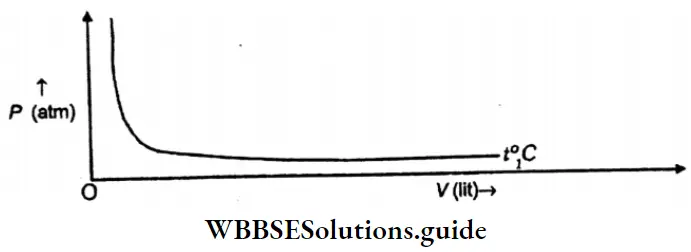
Question 22. When a balloon inflates, it seems to violate Boyle’s law. Explain.
Answer:
When a balloon inflates, it seems to violate Boyle’s law.
Explanation: When a rubber balloon is inflated with the end of a pump, the pressure inside increases but the volume instead of suffering, decreases in accordance with Boyle’s law increases.
This happens because, with the introduction of air, the mass of the gas increases resulting in an increase in volume Thus, inflation of a balloon by mouth or pump appears to violate Boyle’s law but it is not so in the true sense.
Question 23. Deduce the mathematical expression of Charle’s law.
Answer:
The mathematical expression of Charle’s law:
Let Vo be the volume of a definite mass of a gas at 0°C, then the volume of 1°C rise in temperature will be = \(\left(\mathrm{Vo}+\mathrm{Vo} \times \frac{1}{273}\right)\)
The volume of t°C rise in temperature will be = \(\mathrm{Vo}+\mathrm{Vo} \times \frac{1}{273}\)
If Vt represents this volume at t°c
It \(V t+V_0+V_o+\frac{t}{273}=V_0\left(1+\frac{t}{273}\right)\)
similarly, when the temperature at the same mass of gas is gradually made to decrease its volume at t°C is given by
\(V t+V o+V o \times \frac{l}{273}=V_0\left(1-\frac{l}{273}\right)\)“WBBSE Class 10 Behaviour of Gases short answer questions, Physical Science Chapter 2”
Question 24. Establish the combined law of Boyle’s and Charle’s laws.
Answer:
Combination of Boyle’s law and Charle’s law:
Let V be the volume of a given mass of gas at pressure P and temperature T (absolute)
From Boyle’s law, \(\mathrm{V} \propto \frac{1}{\mathrm{P}}\) [When temperature and mass of the gas are constant]
From Charle’s law, V α T [When pressure and mass of the gas are constant]
∴ \(V \propto \frac{T}{P}\) when both T and P vary.
or, \(V=\frac{K T}{P} \text { or, } \frac{P V}{T}=K[K \text { constant }]\)
Now, if V1 is the volume of a gas at pressure P1 and temperature T1 and V2 is the volume of the same amount of gas at pressure P2 and temperature T2 then,
\(\frac{P_1 V_1}{T_1}=\frac{P_2 V_2}{T_2}\)“WBBSE Class 10 Physical Science Chapter 2, Behaviour of Gases important short answer questions”
Question 25. Define-Partial law.
Answer:
Partial law: The partial pressure of any constituent gas or vapour in a mixture is defined as the pressure which the said gas would exert if it alone had occupied the entire volume occupied by the mixture, with temperature in both cases remaining the same.
Question 26. Draw a graph between pressure (P) vs volume (1/V) at constant pressure.
Answer:

Question 27. Draw V vs t at constant pressure (P) for Charles law.
Answer:

“Class 10 WBBSE Physical Science Chapter 2, Behaviour of Gases short answer key”
Question 28. What is the relation between pressure and density at a constant temperature?
Answer:
The relation between pressure and density at a constant temperature
The density of a gas at a constant temperature is proportional to pressure.
\(\frac{P}{P}=\text { Constant. }\)WBBSE Class 10 Physical Science Solutions
Question 29. Draw a graph of pressure (P) VS temperature (t) at constant volume.
Answer:

WBBSE Notes For Class 6 Junior School Geography

- Chapter 1 The Universe and Solar System Notes
- Chapter 2 Shape of The Earth: Is The Earth Around? Notes
- Chapter 3 Location of a Place on The Earth’s Surface Where You Are Notes
- Chapter 4 The Earth’s Motion The Earth Rotation Notes
- Chapter 5 Water – Land – Air Notes
- Chapter 6 The Ice-Capped Continent Antartica Notes


